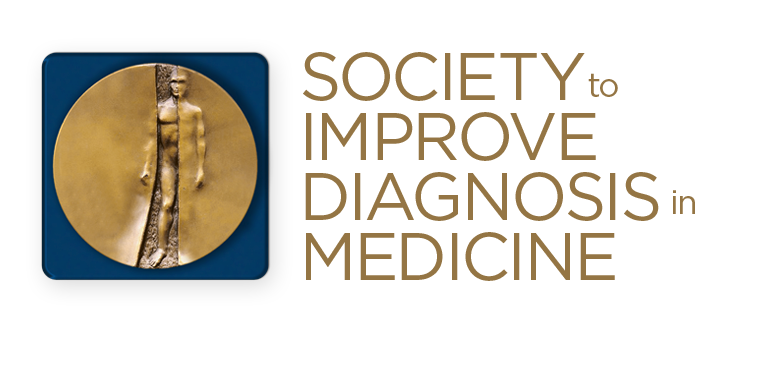PFACs in ACTion
In December of 2019, the Society to Improve Diagnosis in Medicine (SIDM) and the National Academy of Medicine (NAM) co-hosted a meeting of representatives from more than 20 Patient and Family Advisory Councils (PFAC) from across the country. SIDM and NAM engaged PFAC leadership to get their insights on how to drive patient engagement in hospitals and health systems to improve diagnostic quality and safety. Recognizing the influence this important group of leaders has on the C-Suites of their organizations, the meeting was designed to support them in bringing a diagnostic quality and safety focus back to their home institution.

Michael McGinnis engages PFAC leadership to learn how to drive patient engagement in hospitals and health systems to improve diagnostic quality and safety.
The meeting was held at the NAM Keck Center and included opening remarks from SIDM’s CEO Paul Epner and Michael McGinnis, NAM Senior Scholar and Executive Director of the NAM Leadership Consortium for a Value & Science-Driven Health System.
Sue Sheridan, former Director of Patient Engagement at SIDM, demonstrated how to identify patient and family “what if” questions by mapping diagnostic errors against the NAM diagnostic process diagram, and identifying the points along the process where errors could have been prevented.
Armando Nahum, a PFAC representative at MedStar Health who lost his son due to a delayed sepsis diagnosis, presented information about the work his PFAC is doing to reduce diagnostic errors in sepsis.
Tori Bayless, President and CEO of the Association of American Medical Colleges and CEO of Luminis Health, discussed how C-Suite leaders need to be an ally to patients and their families. She offered important advice about integrating diagnostic quality and safety into the work that is happening every day, as opposed to it being a side project: “Don't be afraid of the C-Suite. Be persistent in getting their attention and try not to have your work shuttled off to the side in parallel. Have it be in the mainstream of the work that's happening every day in the organization.”
A focus of conversation at the meeting was how to use the Health Research & Educational Trust (HRET)/SIDM Change Package, Improving Diagnosis in Medicine, to drive change. The change package was the result of a collaboration between the HRET Hospital Improvement Innovation Network team and SIDM, with contributions from patients and their families. Lydie Marc, Performance Improvement Coach from HRET noted, “We know [diagnostic error] is a problem, but most of the time when you have a problem, the next questions that you have are, ‘what can I do or what are the resources that are available to me in order to address this issue? What can I share with individuals in my organization or in my community? What can I do to support quality improvement initiatives?’” Lydie showcased how PFACs can leverage the change package to improve diagnosis in their home institutions.
Participants noted that different hospitals and health systems are at different levels of understanding of the scope of harm from diagnostic error and the need for efforts to improve diagnostic quality and safety. “We want to meet people where they are. We want to meet organizations where they are. How do we help our PFAC members to figure out where their organization is?” asked Vanessa Deen Johnson, from Stanford Healthcare. “We work with a lot of different hospitals and health systems and some are figuring out what diagnostic error is. Others realize they have a problem but have not prioritized addressing it. Somehow we need to identify where people are to know where to start.”
The PFAC leaders spent the day discussing approaches to build and support diagnostic quality and safety activities in their systems. They discussed:
- Barriers and opportunities to engaging their leadership (e.g. Safety and Quality Officer, C-Suite, and Board).
- Maximizing internal communications within the hospital to raise awareness of the PFAC and the work on diagnostic errors.
- Prioritizing diagnostic quality and safety in their institution.
It was also clear from the discussions that there isn’t enough collaboration between PFACs across the nation. Together, they are a powerful force to influence healthcare delivery and quality. SIDM engaged the leaders in a discussion about:
- How can these leaders connect with other PFACs?
- How do we build capacity for other PFACs on diagnostic error?
- How can we collaborate on diagnostic improvement projects and learn from each other?
- How do we prioritize diagnostic quality and safety nationally?
The Coalition to Improve Diagnosis was well represented at the meeting with representatives from the Agency for Healthcare Research and Quality, Centers for Medicare & Medicaid Services, MedStar Health, Consumers Advancing Patient Safety, and Kaiser Permanente in attendance.
As a result of the meeting, SIDM plans to produce two guides—one to help PFACs raise diagnostic quality and safety as a priority in their institutions, and one to support quality and safety leaders on how to best engage PFACs in their work.

Get ACT Update Delivered to Your Inbox
Want to see more content like this? Stay informed on that latest activities from members of the Coalition to Improve Diagnosis. Sign up for the ACT Update Newsletter.

